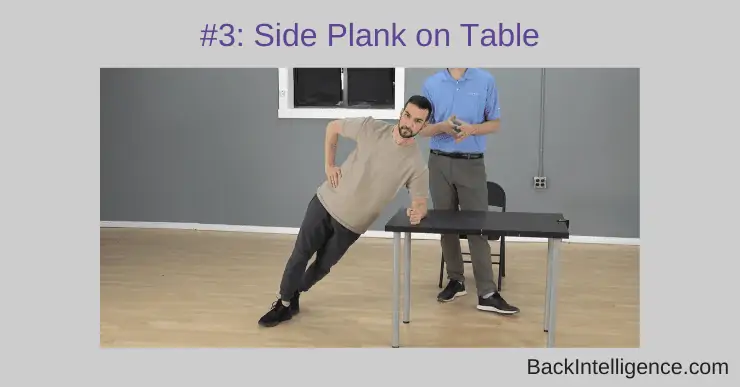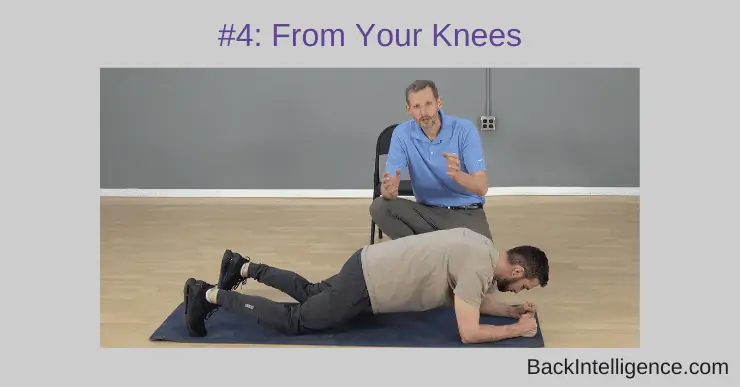
The traditional Plank exercise is great for core strength and many people are familiar with it, but many folks struggle to do it correctly. Commonly, people have the positioning wrong, or they feel it in the wrong places such as their legs or lower back. This is why we have included 4 plank variations below, which make them easier and safer to do.
If don’t feel like you are doing the plank correctly, or if you struggle to get down on the floor, try the plank exercise variations below. Once you build up some strength with these, you can go back to trying planks on the floor and see how you do.
4 Plank Variations (Regressions)
The key with doing these plank type exercises is to really lock in your core, brace, and feel your core on fire. You don’t want your shoulders to take over, and you definitely don’t want to feel it in your low back.
Plank Variation #1: High Plank on Table (Hands)
This is the easiest plank regression for anyone who is struggling to do planks on the floor. It’s also convenient because you can do it almost anywhere. You don’t have to use a table. You can use the back of your couch, a bed, a dresser, or a kitchen counter.
- Engage your core first and maintain that engagement. Imagine someone’s punching you in the stomach and tighten up those core muscles.
- Put your hands-on the table, keep the core tight, and step back with both of your legs.
- Hold this position, and make sure you feel it in your core
- Make sure that your low back stays leveled. Don’t let it dip down or arch.
* To add difficulty, you can either use a lower surface or go to your forearms.
Plank Variation #2: Plank on Table (Elbows)
- Engage your core first and maintain that engagement. Imagine someone’s punching you in the stomach and tighten up those core muscles.
- Lower yourself to your forearms instead of bracing with your hands
- Step back one leg at a time farther away from the table
- Keep you core tight and engaged
- Hold this position, and make sure you feel it in your core
- Make sure that your back stays leveled and doesn’t sag.
Plank Variation #3: Side Plank on Table
If you’re familiar with side planks on the floor, this a variation that’s a bit easier to do using a table or some other object at a similar height.
- As always, tighten and engage your core muscles first
- Position yourself sideways to the table and lean onto the table with your forearm
- Step out from the table with a staggered stance that doesn’t hurt your ankles
- Hold this position, and make sure you feel it in your core
- Alternate and do the other side
Plank Variation #4: Plank On Your Knees
If you don’t have trouble getting on the floor, you might want to try this plank regression. This is very similar to a regular plank exercise, but with one change that will make it easier for you.
- Start by laying on the floor, completely down at first.
- Tighten up and brace your core.
- Come up to your on to your knees and forearm
- Hold this position, make sure you feel it in your core
- Do not let your back sag or arch
Start with short reps instead of trying for one, long rep like most people do.
Instead of doing a 2-minute plank, we recommend 10 or 20 second holds, taking a break, then repeating as many times as you can until your core fatigues.
Watch Video On Plank Variations:
When you feel comfortable doing one of these regressions, move up to the next one. Keep doing them until you can try the regular plank and see how you feel.
Related:
Dead Bug Core Exercise – 3 Progressions
Abdominal Bracing VS Drawing In – For Core Exercises
Are Crunches & Sit Ups Bad For Your Back?
6 Exercises to strengthen lower back and core muscles
Corrective Exercise Specialist (NASM-CES), Certified Personal Trainer (NASM-CPT), Professional Dancer
As a long time back sufferer Leon found unique methods to alleviate his pain using natural methods including self massage, exercise/stretching and postural habits. He founded Backintelligence.com to empower others to fix their postures and ease their back pain from home.




